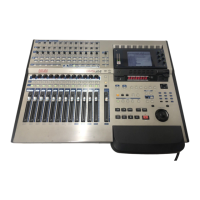40
DPS24 MODES
DPS24 MODES
Running below the LCD are the DPS24’s ‘mode’ keys:
MAIN
SCREEN EDIT MIXER AUTOMATE FX PROJECT SETUP
DSP PATCH V-TRACK CD-RGRID
These are:
MAIN SCREEN This is the main operating screen that one normally works in. It shows the project name,
meters and an overview of the project.
Its SHIFT function shows an enlarged project display.
EDIT Allows you to edit audio with functions such as copy, cut, paste, etc. This mode’s shift
function gives access to the DPS24’s off-line DSP functions such as timestretch, pitch
shift, etc.
MIXER Allows access to certain mixer and channel views. Its SHIFT function shows the PATCH
pages where you may route signals within the DPS24 (although this can be achieved
more easily from the front panel).
AUTOMATE Allows you to set automation functions.
FX Takes you to the effects pages where you may select and edit the DPS24’s internal
effects.
PROJECT Allows you to load and create projects. Its SHIFT function gives access to the ‘virtual
tracks’ function.
SETUP Allows you to set global parameters such as timecode and digital sync options, etc., that
affect the DPS24 as a whole.
Its SHIFT function allows access to the CD-R functions for backing up to, mastering to
and playing back from the (optional) CD-R.
One powerful aspect of the DPS24’s operation is that you do not have to stop playback (or whatever else you may be
doing) to access the different modes or other functions on the unit. Thus, you can be recording and perhaps during
record, switch to AUTOMATION mode to set some automation parameters up in advance. You could be playing
back and switch to EDIT mode to start editing tracks. Similarly, you can be playing back and enable the Q-Channel
to tweak a channel’s EQ whilst at the same time, switching to the FX mode to set effects.
In other words, the DPS24’s operating system need not get in the way of your creative flow forcing you to stop what
you are doing in order to do something else.

